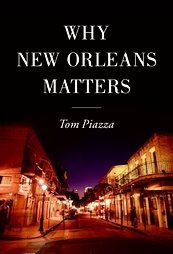
Do you hear that sound, that low moan, distinct from the din of mourning for Katrina’s dead and the utter physical destruction of vast expanses of property and land in Louisiana and Mississippi?
More than a year after the devastation brought by the tropical demon, that sad, synchronized song is growing distant. But it’s still being heard and felt: Those who treasure the unique music, cuisine, architecture and dialect of New Orleans continue to mourn the potential loss of one of American culture’s great natural resources.
The tour books typically, and correctly, point to the depth of American musical roots, the multiple variants of rock and roll, R&B, funk, even hip-hop, in the fertile soil of the city that birthed jazz. It’s the home of Congo Square, from 1817 through 1856 a Sunday-afternoon gathering place for slaves.
There, West African rhythms cross-pollinated with European melodies and harmonies, intermingling with borrowings from Latin America and the Caribbean.
Tom Piazza, a talented music journalist and author of non-fiction works (Understanding Jazz) and novels (My Cold War), accurately and aptly relates the delights and profound cultural influence of the Big Easy in Why New Orleans Matters, a personal and highly subjective but insightful essay-length work that amounts to essential, authoritative reading on the subject. Written quickly during the weeks following Katrina, Piazza’s breezy book is timely and incisive, and it handily fits Matthew Arnold’s description of journalism – “literature in a hurry.”
Piazza begins by relating his own experience as the levees failed, 80% of the city flooded and unbelievably poignant television images of suffering, seemingly abandoned poor residents were beamed all over the world.
“Corpses of neighbors, friends, family members, black and white, were scattered on the sidewalks; people had no sanitary facilities, no medical care and the weakest were easy pickings for the predators among them,” he writes of the goings-on at the Convention Center. “Thousands lived through scenes out of Goya or Hieronymus Bosch. Nobody came through … to give them some hope” (xi-xii).
The author, a New Yorker enamored of the exotic sound of New Orleans music – from Jelly Roll Morton and Louis Armstrong to Fats Domino, Professor Longhair and Dr. John – moved to the Crescent City in 1994, after graduating from the Iowa Writers Workshop. But he fell in love with New Orleans in 1987, when visiting for the Jazz and Heritage Festival, known as Jazz Fest to locals and devotees.
Like others, he was astonished by what he saw, heard, smelled and tasted at the annual festival, one of the most musically catholic events of its kind, an orgy of jazz, blues, gospel, Cajun, zydeco, brass band, folk and rock music and a staggering smorgasbord of crawfish delights, red beans and rice, gumbo and other local food specialties.
Piazza, not surprisingly, is at his best when writing about the city’s music. He correctly assesses the influence of jazz pioneers, including the above and the Original Dixieland Jazz Band (responsible for the first-ever jazz recordings, in 1917), trumpeter King Oliver, and clarinetist Johnny Dodds. He also touches on gospel singer Mahalia Jackson and trumpeter Louis Prima, and notes that the best early work of both Ray Charles (“Mess Around”) and Little Richard were recorded in New Orleans with local musicians.
His prose really comes to life when describing his reaction to the music of The Wild Tchoupitoulas, a group of Mardi Gras Indians backed by the Meters and the Neville Brothers on a still resonant album released three decades ago: “Down amid all those compelling funky-butt rhythms, and all those calls from the chief and responses from the gang … I heard the essence of what I had loved for years in jazz music, blues, bluegrass, and in rock and roll, that mixture of opposite qualities – gravity and buoyancy, go-for-yourself spontaneity and absolute rhythmic precision, seriousness and irony – delivered over certain rhythmic patterns that lived at the center of everything important to me” (48).
The national stage is occupied by ever-present Middle East crises, and the usual partisan politics. Meanwhile, the one-time jewel of the Gulf Coast struggles for rebirth, its decimated population reeling from a spike in violent crime and a damaged tourism industry (that despite respectable attendance for Jazz Fest and a truncated Mardi Gras) and its recovery bogged down in part by local officials tardy in providing a comprehensive plan to spend the billions in federal funds allocated for the region’s redevelopment.
New Orleans’ advocates continue to plead for the survival of their city and its precious, endangered culture; writing as passionate as Piazza’s stands a chance of breaking through the clutter.
(A different version of this review will be published in the Journal of American Culture)




No comments:
Post a Comment